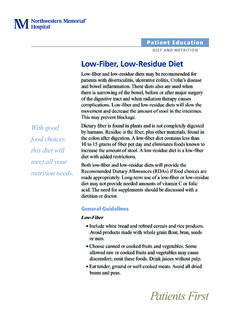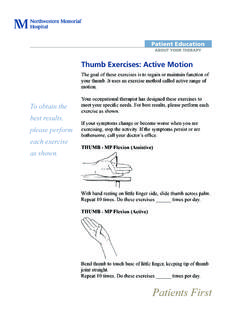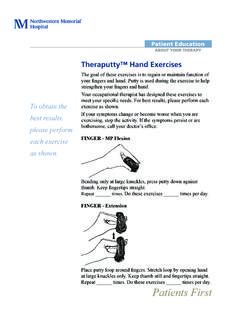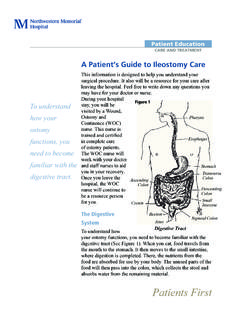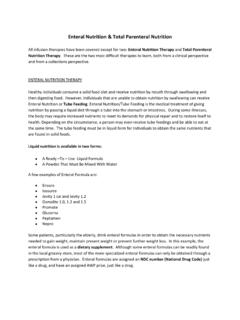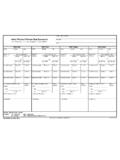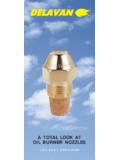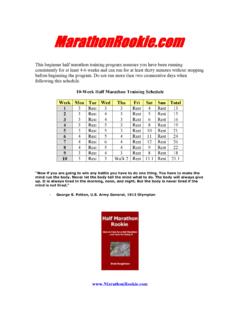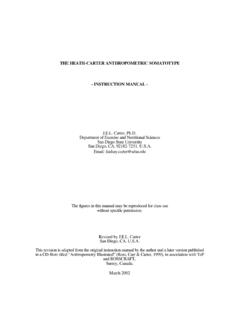Transcription of Total Parenteral Nutrition: Discharge Instructions
1 Handwashingis a very important step in preventing Parenteral nutrition : Discharge InstructionsThis information will help guide you in learning about Total Parenteral nutrition (TPN). Total Parenteral nutrition infuses needed nutrients into your body through a catheter in your vein. Your doctor will decide if you may also eat or drink while on your initial stay in the hospital, you may be on a continuous 24-hour infusion of TPN. When you go home, TPN usually is given once a day over 12 to 14 hours (during the day or night). This is called cycling. Since you will be going home on TPN, it is very important that you become familiar with home TPN; your central venous catheter; proper handwashing method; and possible complications of TPN. Once you are home, you will learn how to: Infuse TPN for yourself. Care for your central venous catheter. Operate the infusion pump. Start and stop your TPN infusion.
2 Heparinize the catheter. Prevent or correct any problems that may occur. Inject medicines into the TPN may be some unfamiliar words in this handout, so please read it carefully and ask questions. One of the members of the Nutritional Support Service will work closely with you and your family to help you prepare for your home TPN program. The team also will assist you while you are on home EducationCARE AND TREATMENTP atients FirstWhen you are ready to go home, plans will be made with a home-care agency and pharmacy supplier. Until you are comfortable with the TPN process, the nurse will visit as often as twice a day. Soon, you or a family member should be able to care for your catheter and infuse your TPN will be made with a home infusion supply company to deliver needed supplies to your home on the day you leave the hospital. You will be given a list of names and telephone numbers of resource people.
3 Some are available on a 24-hour basis by telephone to help you with any problems that may TPN SolutionYour TPN solution contains carbohydrates, protein, fat, vitamins, minerals, electrolytes ( , magnesium, potassium) and water similar to what you would receive with a balanced diet. Your body requires these calories to perform daily functions. Without needed calories, the body breaks down its own tissues to meet energy needs. If this continues, weight loss and weakness will result. The number of calories you need is determined by your weight, height, age and activity. After you have reached your goal weight, your TPN solution may be altered to help you maintain this weight SourceCarbohydrates are a source of energy in your diet. The main energy source in the TPN is dextrose (sugar), which is a SourceLipids are a source of energy in your diet that provide you with essential fatty acids. Fat acts to support and protect some of your organs and insulates your body against heat SourceAmino acids are the source of protein in TPN.
4 They are vital for growth, the building of new tissue and the repair of injured tissue. Protein is needed for your body to make healthy bones, muscle, skin, nails and and MineralsTPN contains the suggested daily amounts of vitamins A, B, C, D, E and K. You also will receive trace minerals, which, like vitamins, are needed by the body. These minerals include zinc, copper and are important for bone, nerve, organ and muscle function. The electrolytes in your TPN solution are calcium, phosphorus, magnesium, sodium, potassium, chloride and is a vital part of TPN. Your solution will be adjusted to meet your specific needs so you do not become balance of electrolytes, vitamins and minerals is checked by regular blood tests. When you first go home, you will have blood tests at least once a week. According to your needs and the blood test results, your TPN solution may be TechniqueAseptic technique keeps bacteria away from your catheter, TPN solution and supplies.
5 If bacteria enters your catheter or the catheter insertion site, a blood infection can occur, making you very ill. To prevent this, it is important to wash your hands and the work area carefully. It also is important to keep your supplies in their packages until you are ready to use them. Store supplies in a clean, dry place, away from children and the Work AreaTables and surfaces in your home normally have dust and some germs. The table top or surface you will use to set up your TPN should be clean and dry. It is best to choose a work area away from household traffic and other distractions. Choose a work surface such as a tray, countertop or table. If the surface is washable, clean it with soap and water and dry it with a clean towel or paper towel. If the surface is not washable, wipe it free of dust and spread a clean towel or paper towels over the surface. Avoid coughing or sneezing over the clean surface.
6 Keep pets out of the touching the catheter or your sterile supplies, it is important to wash your hands carefully to remove bacteria. This will help prevent infection of your catheter. Use an antibacterial liquid soap (in a pump). 1. Turn on the water. 2. Wet your hands and wrists. 3. Squirt the soap into your hands and raise a good lather. 4. Scrub your hands thoroughly for at least 2 minutes. 5. Rinse your hands holding them with your fingers pointing downward. Allow the water to run down from your wrists to your fingers (the dirty water flows downward). 6. Dry your hands with a clean you have washed your hands, do not touch anything except your catheter and supplies. If you touch anything such as the telephone or furniture, wash your hands TPN AdministrationKeep TPN bags refrigerated when not in the expiration date on the label. Never infuse the bag if the expiration date has passed.
7 Obtain a new bag from the the bag for leaks, cloudiness or floating particles. If any of these are noted, do not use the bag. Obtain a new bag from the refrigerator. Call the supply company and report the problem to warm TPN to room temperature, remove the TPN bag from the refrigerator at least 2 to 4 hours before the infusion time. Never warm the TPN bag in the microwave. Instead, you can place the TPN bag in a sink and run warm water over Procedure Collect needed supplies. Clean the work area and set up the supplies. Wash your hands. Prepare and inject any needed additives. (See the following section for details.) Refer to pump instruction sheet for connecting tubing and pump AdditivesCertain medicines must be added to the TPN bag just prior to infusing. The most common additives are multivitamins, insulin, Pepcid (famotidine), Sandostatin (octreotide) and Reglan (metoclopramide).
8 Each TPN vitamin or medicine that is added will be tailored to your the vitamins or medication to the TPN bag as you prepare the bag for infusion. At that time, you will have a clean work area and will have washed your Chlorhexidine pads. Syringe(s) with 21 gauge one-inch needle(s) attached. Medication vial and/or multivitamin 1. Remove the protective cap from the vial. Wipe the top with the chlorhexidine pad or, if using a multidose bottle, wipe the top of the bottle. (Do not open more than one multidose bottle at one time.)4 2. Remove the cover from the needle. Pull back the plunger to draw back air. Draw up as much air into the syringe as you will draw up from the bottle. (Example: 10cc air when drawing up 10cc of multivitamin.) 3. Insert the needle into the bottle. Hold the bottle upside down and inject the air into the bottle by pushing on the plunger. 4. Pull back on the plunger slowly until you have drawn up the correct amount.
9 Push the air out. Remove the needle from the bottle. 5. Wipe the injection port on the TPN bag with a new chlorhexidine pad. Insert the needle into the center of the bag s injection port. Slowly push the plunger on the syringe, injecting the solution into the bag. Remove the needle. 6. Gently rock the bag back and forth to mix the medication into the TPN bag. Repeat this procedure for each medication or vitamin additive. Dispose of the needles in the needle box TPN-Related ProblemsTPN complications may occur because of an imbalance of nutrients or electrolytes in your body. Some are quite serious and can lead to severe problems if not treated. Watch for the following symptoms and take the needed (Elevated Sugar)Hyperglycemia is a higher than normal level of sugar in the can occur when the TPN is infused too fast or if the body cannot tolerate the having an infection or taking a medication such as a steroid will make the body less tolerant of large amounts of sugar.
10 If there is too much sugar in the blood, it will spill into the may feel thirsty, nauseated, weak and have a you are spilling sugar into urine, please notify the home care nurse and your physician. Some changes may have to be made in the TPN testing your urine during the TPN infusion, you can tell if spilling sugar. The test strip will turn colors. The home care nurse will show you how to read the test (Low Sugar)Hypoglycemia is a lower than normal level of sugar in the can be caused by stopping the TPN infusion abruptly without a taper down, or too much insulin in the TPN the body is receiving a large amount of sugar, it produces more insulin. When the TPN infusion stops suddenly, the insulin takes longer to stop being produced. The result is a drop in the blood sugar below may feel shaky, nervous, weak, dizzy, sleepy and sweaty. Nausea, headache, or heart palpitations may occur.

